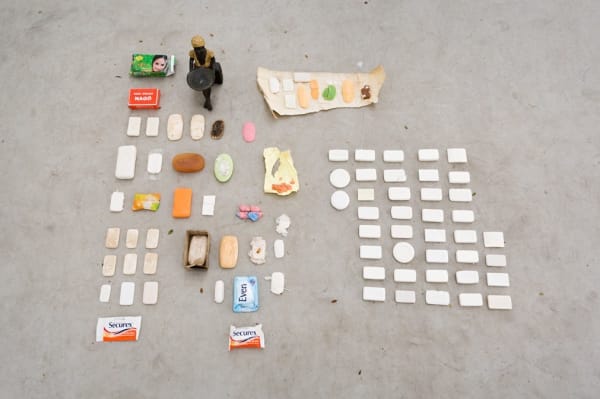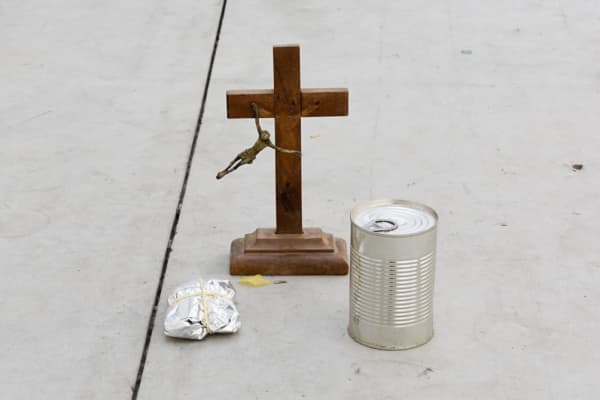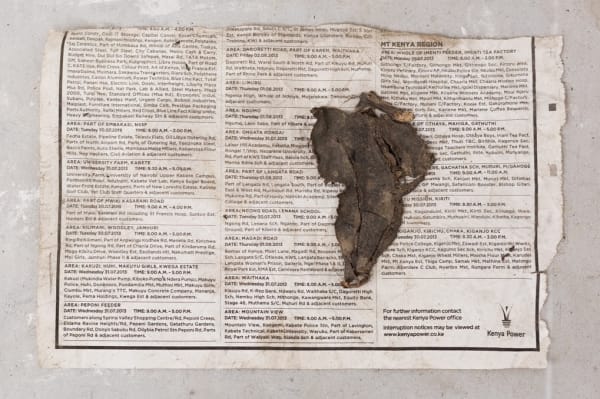Che Cherera Paulo Nazareth
Past exhibition
Overview
In the show Che Cherera, (from the Kaiowa for my name) Paulo presents part of Notebooks of Africa [1], a number of impressions of Africa from there here, of Africa from here there, and of our own Africa with its other developments. Different from the literal sense we can think of, the notebooks in Notebooks of Africa are not a publication, but a number of possibilities: works announced that may or may not materialize (at a given time and space), photographs, videos, reports, and other possible manifestations.
The project begins with a contemplative pilgrimage in the domestic space of the artist himself – the kitchen, the house, the yard, the community where he lives with his family and neighbors (Palmital), and extends to other lands. Through their migrations and displacements, Paulo draws a map of the traits of African and indigenous peoples in our past and present history, recovering forgotten, ignored and erased memories in a territory ranging from Palmital to Santa Luzia (MG), from Santa Luzia to Minas Gerais, from Minas Gerais to Brazil, from Brazil to the Americas and to the world. So far the artist has traveled through Benin, Nigeria, Mozambique, Kenya, Tanzania, South Africa, Argentina, Uruguay, Paraguay; and in Brazil, to São Paulo, Bahia, Goiás, Tocantins, Piauí, Pará, Amazonas, Maranhão, Ceará, Pernambuco, Alagoas, Mato Grosso do Sul, Paraná, Santa Catarina, Rio de Janeiro and Rio Grande do Sul. In the blog which documents the project, an image of the artist with friends and neighbors in the community on a day to beat slab – the joint effort to build each other's homes, and a text announces intentions and parameters: KNOW WHAT HAS OF AFRICA IN MY HOUSE [KNOW WHAT THERE IS FROM AFRICA IN MY HOME] PALMITAL, sector 7, Santa Luzia / MG –BRAZIL – KNOW AFRICA BEFORE YOU ARRIVE IN EUROPE – KNOW WHAT THERE IS OF MY HOUSE IN EUROPE – KNOW WHAT THERE IS OF AFRICA IN EUROPE ...
Besides photographs, three videos of the series are part of the show: Malvenido (2010) [Malvindo]; Estrangeiro Nacional (2012) [Foreign National]; Paseo en el barrio rico de Buenos Aires (2010/2011) [Journey in the rich district of Buenos Aires]; and Malvenido (2012), eponymous video of the series. All three works deal with issues of perception and belonging: the place assigned, in specific contexts, certain social subjects: the black, the mulatto, the poor, the nearly whites poor like blacks and the nearly whites blacks for being so poor [2]. In Foreign National (2012), a video that is 13 minutes long, Nazareth records his experience of arrival and reception at a hotel in Belém do Pará. Prevented by security from entering the hotel, the artist tries to negotiate the misperception and rebuild a perceived image.
The choice of records in black and white, for images that are sometimes oscillating, unfocussed and inaccurate, blur any attempt at defining and framing racial and social identities, our collective misunderstanding. As is common throughout the artist's work, the concept of identity is in a constant process of construction and negotiation.
In direct dialogue with the works of Che Cherera (2014), there is another artist's exhibition in São Paulo. [3] In this other embodiment of Notebooks of Africa, a black man, an immigrant from Pernambuco to Sao Paulo, shares stories of northeastern workers in the city of São Paulo – this Paulista Africa.
Contrary to what the observer who is unsuspecting, naïve and hungry for exoticism may think, the work of Paulo Nazareth is heavily political. Free of random and gratuitous elements, the work dismantles our references and questions, without offering definitive solutions concerning the fixed position of certain stereotypes in the contemporary world: what is being black, African or indigenous? What is the political and economic position that these individuals occupy within the structures of power? Who defines these positions? Their migrations, both literal and implied, review the historical processes, pointing to their development. Above all, they bring to light the faces, gestures and ways of being, living and operating of these other subjects, revealing their role, complexity and richness.
Che Cherera is another step in the watching the world by drawing the eyes [4] process; it is one more fragment of this broad memorial work.
Fabiana Lopes is an independent curator based in New York and São Paulo. Her writing has been published in Colors magazine and Flash Art. With nearly two decades of professional experience, Lopes has most recently held the position of Curatorial Assistant at Colección Patricia Phelps de Cisneros and in the past year has contributed to exhibitions and curatorial projects at the Museum of Modern Art, New York, Hauser & Wirth, New York, and Sotheby’s Institute of Art – New York.
[1] Notebooks of Africa is a project that began in 2012 and is still going.
[2] Passage from the song Haiti, by Caetano Veloso.
[3] Memorial of the Migrant (2014) can be seen in the exposition Made by… Feito por Brasileiros, in the Cidade Matarazzo, Alameda Rio Claro XXXXX, between September 9 and October 11.
[4] Passage from the pamphlet Notebooks of Africa, P. NAZARETH EDIC./LTDA, cadernos de africa – belo horizonte – sao paulo – rio de janeiro – BRAZIL – JAN. 2–13 –
– Fabiana Lopes
The project begins with a contemplative pilgrimage in the domestic space of the artist himself – the kitchen, the house, the yard, the community where he lives with his family and neighbors (Palmital), and extends to other lands. Through their migrations and displacements, Paulo draws a map of the traits of African and indigenous peoples in our past and present history, recovering forgotten, ignored and erased memories in a territory ranging from Palmital to Santa Luzia (MG), from Santa Luzia to Minas Gerais, from Minas Gerais to Brazil, from Brazil to the Americas and to the world. So far the artist has traveled through Benin, Nigeria, Mozambique, Kenya, Tanzania, South Africa, Argentina, Uruguay, Paraguay; and in Brazil, to São Paulo, Bahia, Goiás, Tocantins, Piauí, Pará, Amazonas, Maranhão, Ceará, Pernambuco, Alagoas, Mato Grosso do Sul, Paraná, Santa Catarina, Rio de Janeiro and Rio Grande do Sul. In the blog which documents the project, an image of the artist with friends and neighbors in the community on a day to beat slab – the joint effort to build each other's homes, and a text announces intentions and parameters: KNOW WHAT HAS OF AFRICA IN MY HOUSE [KNOW WHAT THERE IS FROM AFRICA IN MY HOME] PALMITAL, sector 7, Santa Luzia / MG –BRAZIL – KNOW AFRICA BEFORE YOU ARRIVE IN EUROPE – KNOW WHAT THERE IS OF MY HOUSE IN EUROPE – KNOW WHAT THERE IS OF AFRICA IN EUROPE ...
Besides photographs, three videos of the series are part of the show: Malvenido (2010) [Malvindo]; Estrangeiro Nacional (2012) [Foreign National]; Paseo en el barrio rico de Buenos Aires (2010/2011) [Journey in the rich district of Buenos Aires]; and Malvenido (2012), eponymous video of the series. All three works deal with issues of perception and belonging: the place assigned, in specific contexts, certain social subjects: the black, the mulatto, the poor, the nearly whites poor like blacks and the nearly whites blacks for being so poor [2]. In Foreign National (2012), a video that is 13 minutes long, Nazareth records his experience of arrival and reception at a hotel in Belém do Pará. Prevented by security from entering the hotel, the artist tries to negotiate the misperception and rebuild a perceived image.
The choice of records in black and white, for images that are sometimes oscillating, unfocussed and inaccurate, blur any attempt at defining and framing racial and social identities, our collective misunderstanding. As is common throughout the artist's work, the concept of identity is in a constant process of construction and negotiation.
In direct dialogue with the works of Che Cherera (2014), there is another artist's exhibition in São Paulo. [3] In this other embodiment of Notebooks of Africa, a black man, an immigrant from Pernambuco to Sao Paulo, shares stories of northeastern workers in the city of São Paulo – this Paulista Africa.
Contrary to what the observer who is unsuspecting, naïve and hungry for exoticism may think, the work of Paulo Nazareth is heavily political. Free of random and gratuitous elements, the work dismantles our references and questions, without offering definitive solutions concerning the fixed position of certain stereotypes in the contemporary world: what is being black, African or indigenous? What is the political and economic position that these individuals occupy within the structures of power? Who defines these positions? Their migrations, both literal and implied, review the historical processes, pointing to their development. Above all, they bring to light the faces, gestures and ways of being, living and operating of these other subjects, revealing their role, complexity and richness.
Che Cherera is another step in the watching the world by drawing the eyes [4] process; it is one more fragment of this broad memorial work.
Fabiana Lopes is an independent curator based in New York and São Paulo. Her writing has been published in Colors magazine and Flash Art. With nearly two decades of professional experience, Lopes has most recently held the position of Curatorial Assistant at Colección Patricia Phelps de Cisneros and in the past year has contributed to exhibitions and curatorial projects at the Museum of Modern Art, New York, Hauser & Wirth, New York, and Sotheby’s Institute of Art – New York.
[1] Notebooks of Africa is a project that began in 2012 and is still going.
[2] Passage from the song Haiti, by Caetano Veloso.
[3] Memorial of the Migrant (2014) can be seen in the exposition Made by… Feito por Brasileiros, in the Cidade Matarazzo, Alameda Rio Claro XXXXX, between September 9 and October 11.
[4] Passage from the pamphlet Notebooks of Africa, P. NAZARETH EDIC./LTDA, cadernos de africa – belo horizonte – sao paulo – rio de janeiro – BRAZIL – JAN. 2–13 –
– Fabiana Lopes
Works
-
 Paulo Nazareth, CA - Arco tabaco, 2013-2014
Paulo Nazareth, CA - Arco tabaco, 2013-2014 -
 Paulo Nazareth, CA - Bandera branca, 2014
Paulo Nazareth, CA - Bandera branca, 2014 -
 Paulo Nazareth, CA - Cabelo, 2012-2014
Paulo Nazareth, CA - Cabelo, 2012-2014 -
 Paulo Nazareth, CA - CABRITO, 2013/2014
Paulo Nazareth, CA - CABRITO, 2013/2014 -
![Paulo Nazareth, CA - CAPANGA [Guarani], 2014](data:image/gif;base64,R0lGODlhAQABAIAAAAAAAP///yH5BAEAAAAALAAAAAABAAEAAAIBRAA7) Paulo Nazareth, CA - CAPANGA [Guarani], 2014
Paulo Nazareth, CA - CAPANGA [Guarani], 2014 -
![Paulo Nazareth, CA - CAPANGA [Jasmine Rice], 2014](data:image/gif;base64,R0lGODlhAQABAIAAAAAAAP///yH5BAEAAAAALAAAAAABAAEAAAIBRAA7) Paulo Nazareth, CA - CAPANGA [Jasmine Rice], 2014
Paulo Nazareth, CA - CAPANGA [Jasmine Rice], 2014 -
 Paulo Nazareth, CA - Chorisso, 2012-2014
Paulo Nazareth, CA - Chorisso, 2012-2014 -
 Paulo Nazareth, CA - comida de caboclo, 2014
Paulo Nazareth, CA - comida de caboclo, 2014 -
 Paulo Nazareth, CA - DUPRESO, 2014
Paulo Nazareth, CA - DUPRESO, 2014 -
 Paulo Nazareth, CA - ELEFANTEHIPOPO, 2013-2014
Paulo Nazareth, CA - ELEFANTEHIPOPO, 2013-2014 -
 Paulo Nazareth, CA - Figurinha repetida, 2014
Paulo Nazareth, CA - Figurinha repetida, 2014 -
 Paulo Nazareth, CA - for BLACK, 2014
Paulo Nazareth, CA - for BLACK, 2014 -
 Paulo Nazareth, CA - for clair, 2013-2014
Paulo Nazareth, CA - for clair, 2013-2014 -
 Paulo Nazareth, CA - girafa, 2014
Paulo Nazareth, CA - girafa, 2014 -
 Paulo Nazareth, CA - Hoteis baratos do sul, 2012-2014
Paulo Nazareth, CA - Hoteis baratos do sul, 2012-2014 -
 Paulo Nazareth, CA - jesus christi jump, 2013-2014
Paulo Nazareth, CA - jesus christi jump, 2013-2014 -
 Paulo Nazareth, CA - Maniva, 2014
Paulo Nazareth, CA - Maniva, 2014 -
 Paulo Nazareth, CA - promessas de amor, 2012-2014
Paulo Nazareth, CA - promessas de amor, 2012-2014 -
 Paulo Nazareth, CA - saboneteira, 2014
Paulo Nazareth, CA - saboneteira, 2014 -
 Paulo Nazareth, CA - SAMBA, 2013-2014
Paulo Nazareth, CA - SAMBA, 2013-2014 -
 Paulo Nazareth, CA - Sem título, 2014
Paulo Nazareth, CA - Sem título, 2014 -
 Paulo Nazareth, CA - Sem título, 2014
Paulo Nazareth, CA - Sem título, 2014 -
 Paulo Nazareth, CA - Sem título, 2014
Paulo Nazareth, CA - Sem título, 2014 -
 Paulo Nazareth, CA - Sem título, 2013-2014
Paulo Nazareth, CA - Sem título, 2013-2014 -
 Paulo Nazareth, CA - Soberano Concórdia, 2014
Paulo Nazareth, CA - Soberano Concórdia, 2014 -
 Paulo Nazareth, black power, da série afro comb, 2014
Paulo Nazareth, black power, da série afro comb, 2014 -
 Paulo Nazareth, CA - Urucum caramujo africano, 2014
Paulo Nazareth, CA - Urucum caramujo africano, 2014 -
 Paulo Nazareth, CA - Sem título, 2013-2014
Paulo Nazareth, CA - Sem título, 2013-2014
Installation Views





![Paulo Nazareth, CA - CAPANGA [Guarani], 2014](https://artlogic-res.cloudinary.com/w_600,c_limit,f_auto,fl_lossy,q_auto,dpr_auto/artlogicstorage/mendeswooddm/images/view/ed19c4a533a596b891d7406661eaa0f2j/mendeswooddm-paulo-nazareth-ca-capanga-guarani-2014.jpg)
![Paulo Nazareth, CA - CAPANGA [Jasmine Rice], 2014](https://artlogic-res.cloudinary.com/w_600,c_limit,f_auto,fl_lossy,q_auto,dpr_auto/artlogicstorage/mendeswooddm/images/view/820fa0f4cd39f25ac7bec6fb14ccde84j/mendeswooddm-paulo-nazareth-ca-capanga-jasmine-rice-2014.jpg)























